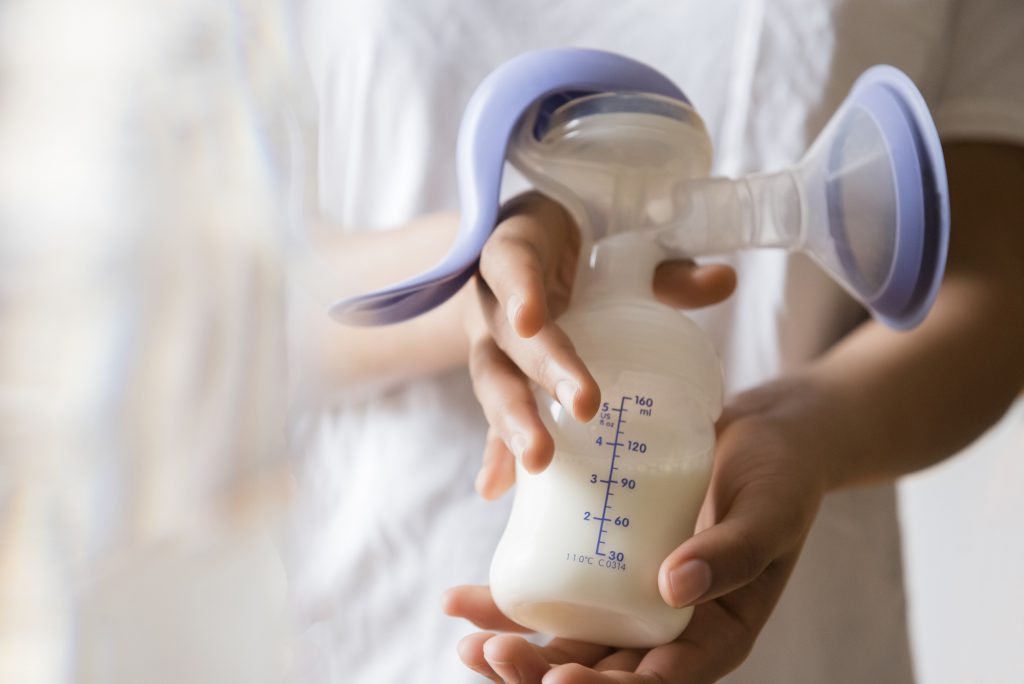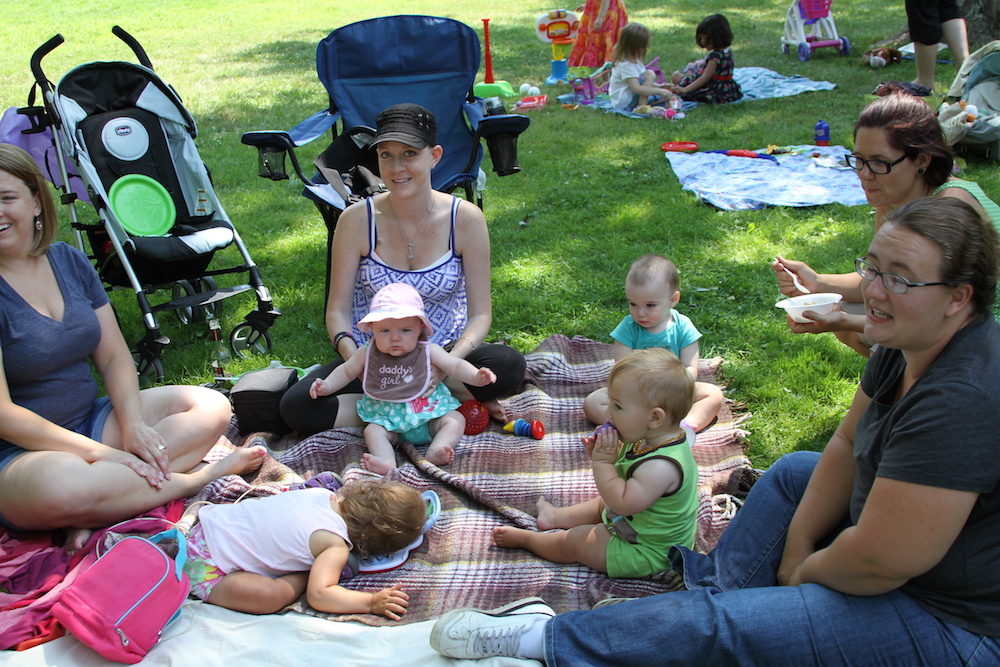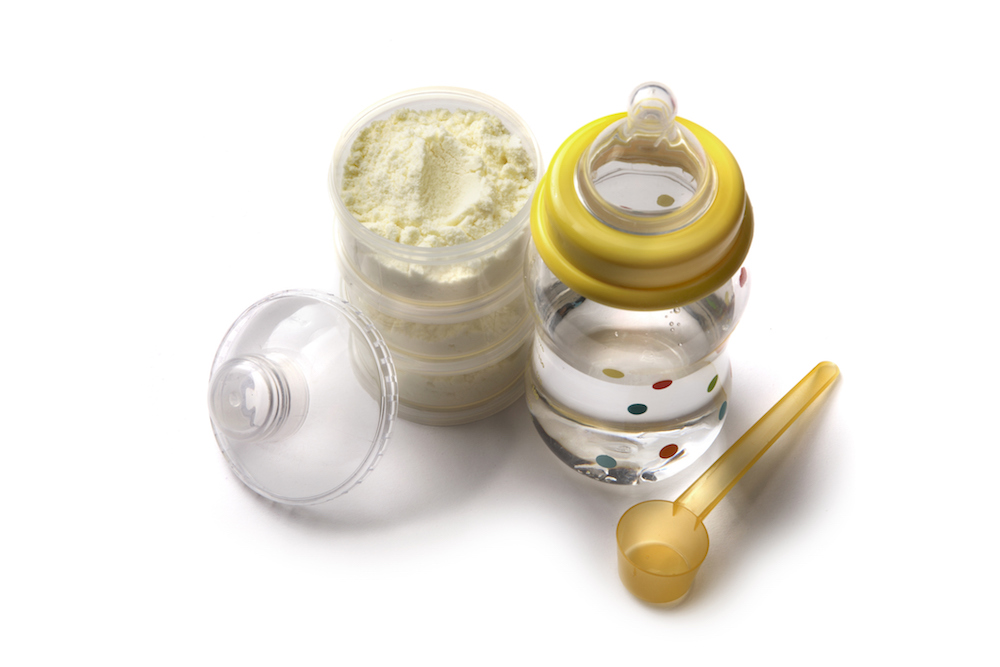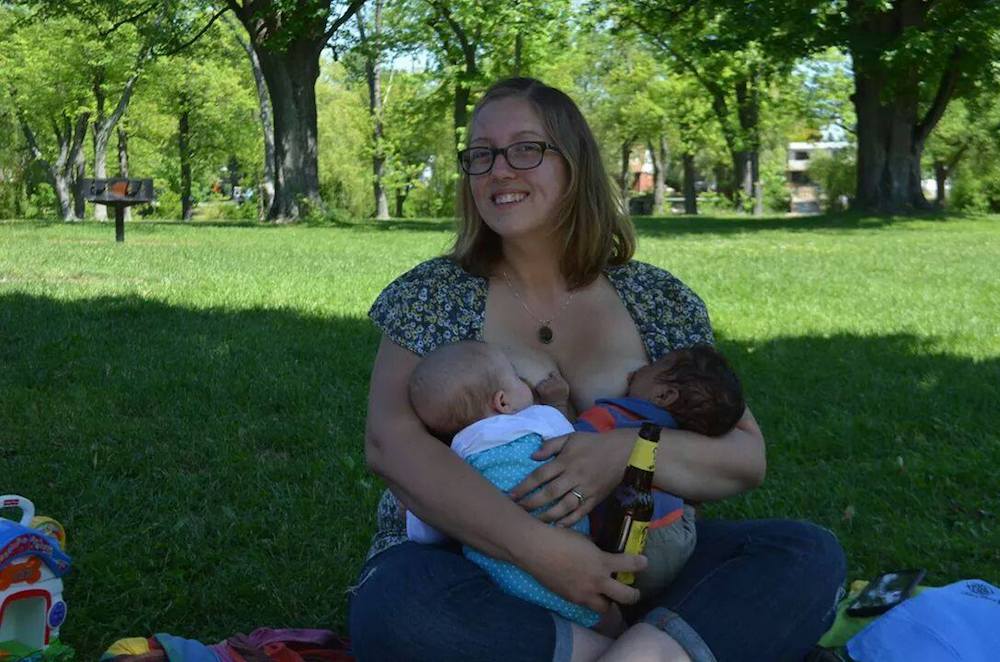What Milk-Sharing Communities Reveal

Heather Wascak was devastated. In 2014, within days of giving birth to a baby girl, Lucia, she was aching to be with her child.
“She’s almost 5 days old, and I still haven’t gotten to hold her,” Wascak wrote in a Facebook post. “In fact, I’ve only gotten about 10 minutes with her. Anyone who knows me knows that this was 100 percent not my birth plan.”
Wascak had wanted an intimate home birth with a midwife, as she’d had with her first child. Instead, she’d needed to have a cesarean section. Wascak was fighting a rare fallopian tube cancer. And even though she was desperate to breastfeed her baby, initially she couldn’t, in part because doctors transferred Lucia, who was having difficulty breathing, to another hospital.
Committed to giving her child breast milk, Wascak turned to other women who were breastfeeding and willing to share. A local breastfeeding group in Buffalo, New York, stepped up to support her, as did donors she had never met, who connected through online networking after reading her Facebook posts. Wascak recorded her thanks online: “So many mamas have reached out and offered their breast milk for Lucia. I can’t put into words how grateful I am for that.”
Wascak’s story is one of many collected by Aunchalee Palmquist, a medical anthropologist at the University of North Carolina at Chapel Hill. Such stories, Palmquist believes, may challenge people’s assumptions about women sharing their milk, a practice that has raised concerns among medical professionals.
These sharing groups are organized informally, most often without unified guidelines or medical supervision. Doctors have many fears about the practice, not least of all because milk can potentially carry pathogens, including human immunodeficiency virus (HIV).
Nonetheless, an increasing number of women in the United States and around the world are sharing milk informally with other mothers. “It’s definitely a phenomenon among at least American women,” says Melanie Martin, an anthropologist at the University of Washington, Seattle, “and understanding it is part of a whole history of human milk sharing and cooperative breeding.”
Some of this movement reflects a slow shift from formula back to breastfeeding in many societies. Over the last four decades, medical professionals have recognized the irreplaceable health benefits of breast milk and recommended that infants consume only breast milk (rather than formula or occasional solids) until 6 months of age. As demand for breast milk grows, peer-to-peer milk-sharing networks have flourished, as have nonprofits that bank human milk (analogous to community blood banks) and commercial efforts to capitalize on breast milk’s purported health benefits.
Anthropologists such as Palmquist and Martin feel there’s a lot for researchers to learn from these trends, particularly the peer networks. Health risks may exist, they argue, but medical personnel need to become more involved in connecting women to solutions, rather than just rejecting the practice.
In the meantime, the trend provides insights into the complex rules that cultures construct around maternal behavior. “For me as an anthropologist,” Palmquist says, “studying milk sharing opens up windows on racism, gender identity, having a baby, community, and what it means to be a parent.”
Medical practitioners, biologists, and public health specialists have identified a slew of benefits to infants who breastfeed, including immune system protection and fewer ear infections. Women who breastfeed have a lower risk for breast and ovarian cancers. And breastfeeding facilitates psychological bonding between mother and child.
Partly because of such research, in 2002, the World Health Organization began promoting exclusive breastfeeding for the first six months of a baby’s life. In addition to breast milk’s benefits, the WHO recognizes that formula requires clean water and a certain level of sanitation, conditions that are not available in every community.
That 2002 guidance was a sign of how powerfully new findings have shifted opinion in recent years. In the early 20th century, the medical establishment accepted formula as scientifically safe. Aggressive marketing campaigns made it sound superior to breastfeeding. In addition, formula offered a shelf-stable option for feeding infants in a variety of circumstances. It was the first choice for infants in intensive care units in many U.S. hospitals until recently.
Even as researchers have enhanced manufactured options, the limits of these products become increasingly clear. Breast milk’s composition is complex and dynamic; it changes throughout breastfeeding and a baby’s growth, which makes it difficult for formula companies to mimic.
Still, the return to breast milk has had complicated consequences. Under the “discourse of ‘breast is best,’” says Beatriz Reyes-Foster, a sociocultural anthropologist at the University of Central Florida, failing to breastfeed means “your body is failing you, [and] you are failing as a mother.”
Mothers whose milk does not “come in,” for instance, may feel shamed for their inability to provide breast milk. Meanwhile “super producers,” who are able to provide an abundance of milk, want to help others.
The best-established system for sharing extra milk is via milk banks, many of which operate as nonprofit organizations to serve their local communities. A scattering of these groups existed in the U.S. in the 1970s. In the 1980s, the threat of HIV, which can be passed in mother’s milk, led most of these efforts to shut down until after researchers found that pasteurization killed the virus. Today milk bank guidelines specify that these nonprofits pasteurize all milk.
Their donations go to babies most in need: predominantly infants in neonatal intensive care units (NICUs), whose survival may be pinned to breast milk. The Human Milk Banking Association of North America (HMBANA), which considers donor milk a “medicine” for premature babies, reported that in 2019, its members distributed nearly 5.85 million ounces of milk to NICUs and 1.5 million ounces to babies at home, donated by 12,491 volunteers.
Milk banks are safe sources of breast milk, but they can’t meet the demands of all mothers and babies.
The banks are safe sources of breast milk, but they can’t always meet the demands of all mothers and babies. That limitation, anthropologists have found, is at least one reason why women seek other solutions.
From an evolutionary viewpoint, milk sharing is a very old human practice. In the late 1990s, Sarah Blaffer Hrdy, emeritus professor of anthropology at the University of California, Davis, drew upon data and observations across primates to study allomaternal care, that is, mothers helping tend one another’s children. In some cases, she found, mothers share nursing as well.
This research made two things clear. First, humans evolved to be cooperative breeders, meaning that all parents need help raising and feeding their children.
Second, the rules surrounding this behavior can be complex. Even among our primate cousins such as capuchins and other monkeys, the offspring of others are sometimes welcomed and sometimes rebuffed.
Humans are just as varied in their behaviors, practicing milk sharing in different ways across societies. For instance, infants of the Aka hunter-gatherers living in the Congo Basin may have spent nearly a quarter of their time nursing with another mother. Meanwhile, other hunter-gatherer groups, such as the !Kung of Botswana and Namibia, do not share milk.
“Looking at what we see in extant hunter-gatherers today, we see variation, and we would expect that variation in the past,” says Martin, who has studied breastfeeding practices in the Bolivian Amazon and elsewhere.
That diversity means that various cultures specify distinct norms or “rules of behavior” for motherhood. Even before women worried about how their society viewed breast milk versus formula, mothers were making choices about breastfeeding informed by these community norms.
In some Muslim communities, for example, sharing the same woman’s milk makes children kin, even if they are not otherwise tied by blood. That fact adds a layer of complication to establishing milk banks in certain countries.
Historically, in many countries, a woman who fed another’s child was a wet nurse, often a servant or slave. In 18th-century France, Hrdy’s work reveals, wealthy families recruited poor women as wet nurses. Impoverished mothers earned money for their family but could not be with their own children, often leaving sons and daughters in foundling homes. Meanwhile, some wealthy urban families sent their newborns to live in a wet nurse’s home in the countryside, separating mother and child from birth.
These histories cast long shadows. In 2017, historians Emily West and R.J. Knight at the University of Reading noted that the experiences of enslaved Black women who were forced to serve as wet nurses to White families in the southern United States before the abolition of slavery may contribute to lower rates of breastfeeding in African American communities today.
The movement to share milk peer-to-peer in the United States, however, differs from these stories of exploitation, in part because of its focus on building community. What might historically have been considered inherently unequal—wet-nursing—becomes something else among peers.
Mary Miller started the breastfeeding group in Buffalo that Wascak joined years ago. “We had the best friendship ever,” Miller recalls.
The two tag-teamed to care for each other’s kids and cross-nursed their children. Miller, a former social worker, eventually helped with Wascak’s cancer therapies and end-of-life care.
Miller loves Lucia, Wascak’s daughter, and notes that cross-feeding often makes women feel connected to others’ children—perhaps because breastfeeding releases the hormone oxytocin, which promotes bonding. “People feel uncomfortable with cross-nursing,” Miller acknowledges, “but it creates a special bond with a child.”
Now an international board-certified lactation consultant, Miller has helped thousands of women donate and receive breast milk. The participants in her groups are predominantly, though not exclusively, White. They tend to have at least high school diplomas; many have bachelor’s degrees, and some have higher levels of education.
The groups are socioeconomically diverse. Some women receive food stamps but share milk they can spare. Wealthier participants sometimes anonymously support others in the group, perhaps donating a car seat. They communicate online and meet in person.
Finding one another through social media is a common pattern in these groups, anthropologists have discovered. “It shows how the internet has allowed women to find supportive networks when society has disrupted our efforts to find supportive kin and community,” Martin says.
Across the United States, women from varied backgrounds—in terms of socioeconomic status, race, or ethnicity—are organizing peer-to-peer milk-sharing groups. Participants may be wealthy or poor, educated or not, or from similar or different cultural backgrounds.
They may share pumped milk, cross-nurse, or both, as Palmquist has observed. Reyes-Foster, who studied a peer network mostly comprised of educated, upper middle-class, White women, found that about 20 percent of the women breastfed another woman’s child directly.
These groups often explicitly state that participation must be altruistic and noncommercial. That approach differs from online milk sales or for-profit companies, such as Prolacta Bioscience, which sells milk to NICUs.
But nonprofit banks and for-profit companies come with more standards and established practices, like quality assurance and pasteurization. The fact that peer sharing lacks similar oversight has alarmed many in the medical community.
As news stories have circulated about milk sharing outside of milk banks in the U.S., the public health community has responded with concern. Doctors, epidemiologists, and microbiologists have emphasized that donated milk could carry pathogens, such as HIV, that recipients would be unable to screen. (Researchers don’t know yet whether COVID-19 can be passed through breast milk.)
“Even if you think you know someone, you can’t be certain about their lifestyle and the medications in their breast milk, let alone illicit drugs, alcohol, tobacco, herbal remedies, or the environmental contaminants they’re exposed to at their jobs. Personally, I wouldn’t do it,” pediatrician Diana Mahar told a reporter for the Bay Area News Group in 2011.
Doctors, epidemiologists, and microbiologists have emphasized that donated milk could carry pathogens such as HIV.
In 2017, the American Academy of Pediatrics made an official recommendation against “direct, internet-based, or informal human milk sharing.” The organization’s concern was that such practices simply are not as safe as obtaining milk from a milk bank.
While this may feel accurate to many women, it’s yet to be proven. “We don’t have evidence that casual milk sharing is harmful,” says Amy Vickers, president of the HMBANA and the executive director of the Mothers’ Milk Bank of North Texas. Nonetheless, she notes, donor milk bank guidelines, which include screening donors for infection and guidance on proper milk storage, ensure a higher level of safety.
Anthropologists who study peer sharing and milk banks agree that there are many ethical, medical, and scientific questions to untangle. But they also worry that the medical community has been too quick to dismiss peer sharing.
Dangers exist, acknowledges Palmquist, but what was missing a decade ago, when many doctors dismissed this practice, was an understanding of where these women were coming from and how they shared their milk. Palmquist herself became an international board-certified lactation consultant to inform her research.
Palmquist’s findings suggest peer sharing is safer than relatively anonymous online sales, for example, through online chat groups. She has found that women in peer-to-peer sharing groups work hard to mitigate risk. They check donors they met online through community connections. They meet in person to get their own impressions, ask about medications and eating habits, and forge close relationships to build trust in the women offering milk.
Meanwhile, “people care where their milk goes,” Reyes-Foster notes. Instead of donating to a milk bank, some donors want to meet the babies they feed.
In the meantime, Palmquist fears that the medical establishment’s messages on milk sharing are out of sync with the reality. “Overall, we have to see the big picture,” she says. “Before we begin demonizing the way women are caring for children and infants, we have to understand all the socioeconomic contexts.”
Palmquist, along with cultural anthropologist Tanya Cassidy at Dublin City University and several other scholars, have argued that milk sharing is here to stay, so the medical establishment could help women figure out how to share safely. For example, Palmquist hopes health care professionals might use the evidence from anthropological and medical research to tailor their messages to parents and caregivers. They could assist or even facilitate peer-to-peer sharing in some cases.
A “just don’t” message will not be enough, she contends. “That works as well as telling people to not have sex to avoid sexually transmitted diseases or unwanted pregnancies,” Palmquist says.
Many people in the milk-sharing movement feel society needs to give greater consideration to the diverse needs of mothers in light of new discoveries on breastfeeding and breast milk. Breastfeeding may, for example, offer benefits that even pumped milk cannot deliver.
“In a culture that provides little support for what was once the biological norm, breastfeeding has become something for the privileged,” Miller says. She has counseled women who have decided to quit jobs because they could not breastfeed and work, even though they could not afford to miss a paycheck.
Indeed, women in many varied contexts want to breastfeed and need help. Palmquist cites the transgender parents who also want to provide children with breast milk. Meanwhile, Cassidy, a leading ethnographer of human milk banking, wants both banks and sharing networks to be considered as part of a continuum of options that are carefully vetted but available to mothers in need.
Taking a broad view, the anthropologists who study cross-feeding, milk banks, and milk sharing suggest societies require multiple solutions for varied circumstances. “We can’t shame women,” Hrdy says. “There needs to be some nuance and flexibility and tolerance.”
Mothers choose to provide for their children as best they can—often in the face of great obstacles. For Wascak, her intense desire to breastfeed became a seemingly unattainable goal with her cancer diagnosis. And yet her milk-sharing community provided a bridge to it.
With thousands of ounces of donated milk, her daughter Lucia thrived, reaching 16 pounds in four months. Eventually, Wascak was able to breastfeed Lucia herself. When Wascak died of cancer in 2015, Lucia was 18 months. She had never had formula, and only had human milk, just as her mother had intended.
Editors’ Note: On August 7, 2020, we removed a historical illustration of an enslaved Black woman breastfeeding a White infant. We had selected that image to call out the dynamic of inequality and exploitation described in the text, in which enslaved Black women sometimes were forced to serve as wet nurses by White families. However, we have replaced it upon learning that such imagery has contributed to longstanding stereotypes around breastfeeding among African American women.































